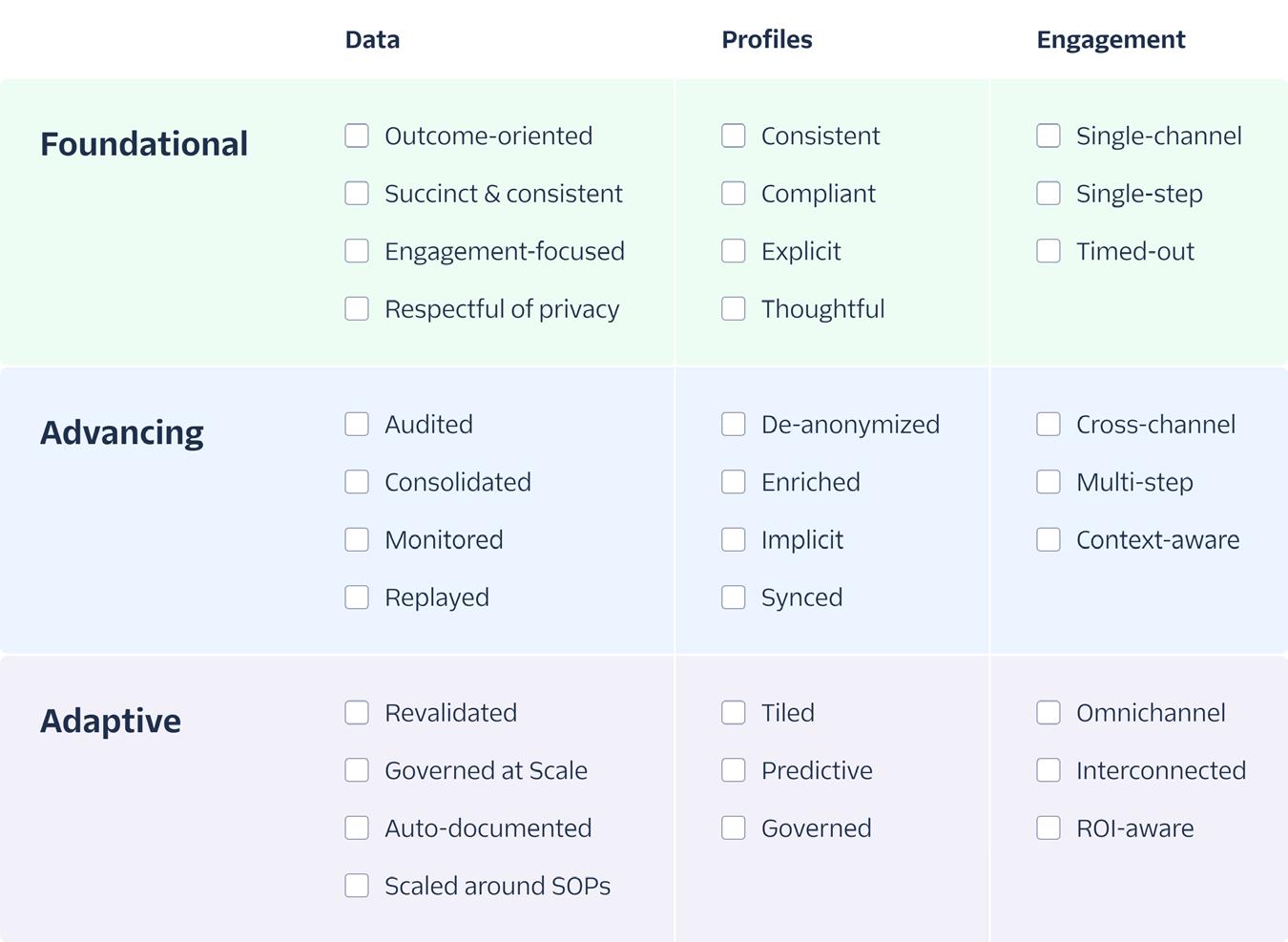
2 minute read
Foundational Engagement
LEVEL 01
Foundational
Advertisement
Collect data reliably around unified profiles and act on it to realize business value
Engagement
Data
Profiles
Single Channel
Single Step
Timed Out
Aligned Identifiers
Compliant Audiences
Explicit Preferences
Thoughtful Spaces
Outcome-Oriented
Succinct & Consistent
Focused on Engagement
Respectful of Privacy
Building world-class customer engagement starts with choosing the right channels and making sure you’re reaching the right audience. It may be tempting to jump right into implementing the ideal customer journey right away, but creating deeper, more impactful engagement with your customers requires a solid foundation.
Single channel
While omnichannel customer engagement can be particularly powerful for your business (more on that later!), when you’re just starting out on your customer engagement journey we encourage you to keep it simple.
For example, let’s say you wanted to message all customers who’ve added at least 5 pieces of clothing to their shopping cart in the past 30 days, but haven’t yet completed a purchase. You might be tempted to build an audience of those specific cart-abandoners and then send that audience first to Facebook and Google Ads, then to an email tool, and finally to your push notifications tool – all with the goal of reducing cart abandonment and increasing conversions.
But why make it so complex? When you’re trying to achieve foundational engagement, it’s completely reasonable to just email all the customers in your audience who have an email address (and have consented to receive emails), and see how that moves the needle on conversions. Then wait a week, and do the same with an advertising campaign on Facebook. Then compare the lift between the two campaigns and see which one performed better.
For the sophisticated digital marketer, this might seem just too simple. Why not split the audience into A/B/C testing groups, and run each group through a different channel? You absolutely can, but in doing so, you’re racing too fast towards advancing engagement before you’ve validated that single-channel campaigns work as expected. In working with thousands of customers, we’ve found that moving slowly and deliberately at first can surface unanticipated complexities with seemingly basic campaigns.
Then, once you’ve ironed out the wrinkles, you can scale with much more speed in the later stages of maturity.
Single step
Just like it’s tempting to send your audience to multiple channels for cross-channel activation, sophisticated CDPs make it equally tempting to build complex journeys with branching logic and nuanced conditions when activating that first audience. While establishing foundational engagement, do everything you can to fight that temptation! Journeys like the one below introduce unnecessary complexity when you’re trying to achieve foundational engagement:
A multi-step journey; this is too complex for foundational engagement!
Just like you want to keep your channels simple during foundational engagement, you want to keep the steps in your journeys simple too. Single-step engagement is just that: the pairing of an entry condition and an activation action to move someone out of that entry condition. And although single-step engagement doesn’t leverage the full power of complex journey-building, it achieves something so much more important: a quick measurable win within your CDP!

Timed out
Audience suppression is essential to avoiding situations where you’re wasting time and money targeting users who don’t fit your target audience and are unlikely to convert. Oftentimes, audience suppression is applied to exclude customers who have already converted from campaigns. However, it is prudent to also “time out” audiences as well – to exclude and suppress users based on how much time they spend in a targeted audience.

The longer a user spends in an audience, the more likely they will experience diminishing returns as you continue to target them. Suppressing users based on how much time they linger is a great way to curate your lists and amplify the success of each campaign, as you will always be targeting the freshest leads.





